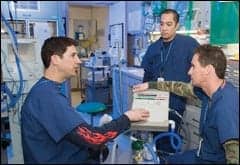Despite a busy holiday season, 24×7 readers found time to offer their thoughts on a number of articles. Dallas Sutton’s recent piece on a common-sense approach to alternative equipment maintenance in particular invited some probing questions on our site.
Binseng Wang, 24×7‘s newest editorial board member, observed that based on his previous research, the instances of “predictable and preventable failure” captured by Sutton’s team are unlikely to exceed “5% of all service records, which means it take a long time to accumulate enough data for statistically valid analyses.
“Such a small amount of records is typically not enough to conclusively prove that the AEM is as safe and effective as if the manufacturers’ recommendations were followed, especially when these PPFs have different root causes,” Wang wrote. He concluded that in order to gather enough statistically valid data, hospitals would ideally pool their data, although he acknowledged that approach probably represents a pipe dream.
J. Scot Mackeil, CBET, wrote that as a biomed with 35 years’ work history, “this ‘new’ way of looking at PM raises a lot of ‘red flags’…We need a CMMS/TJC set of standards for manufacturers to follow when they write their PM procedures” so those requirements “meet our (Biomed/HTM) professional standards.”
For instance, a biomed occasionally encounters manufacturer PM recommendations that don’t follow generally accepted best practice. In those cases, he asked, “is a biomed morally and ethically obligated to uphold the higher of the two standards?”
Sutton responded to both concerns, noting that while Wang’s critiques were valid, “without an AEM program, we lose the ability to modify our programs to meet the specific needs of individual equipment items based on their use and location, not to mention historical reliability.” Since higher-risk items are generally maintained according to manufacturer recommendations anyway, “those items placed into an AEM program are generally of lower overall risk to the patient (and organization) based on the localized data, localized experience and the risk threshold of the owner organization,” he said.
Regarding Mackeil’s query on PM procedures, Sutton wrote, “While I agree that some manufacturer’s should have a more active role writing PM procedures that more closely align with the real world risks, we all have variations in application of the same device, and therefore what might seem as absolutely required for one organization, may be overkill for another. This is where I find so much value in the AEM program as proposed by CMS—it gives each of us the flexibility to make changes to our program based on the specific needs of our equipment and ultimately our customers.”
HTM Salary Survey
Meanwhile, the 2015 salary survey continues to generate lively discussion online.
Susan Stallings, identifying herself as “one of the rare female techs with nearly 25 years in the field of biomed,” wrote, “I have not pursued certification as there has not been an advantage in doing so. I consider getting further training in the IT field to become more comfortable with the ever advancing technology but do not see a clear path to focus on. How do we know where to aim our IT arrow to maximize skills and usefulness in our own field and prepare for my remaining 15 years?”
Pat Lynch and Barb Christe took the time to respond, encouraging Stallings to pursue certifications, particularly those in IT. “I am a believer that you can never have too much education, training, or letters behind your name,” Lynch wrote, adding, “I know lots of biomeds who have moved into IT, Epic, and all sorts of IT integration. Let’s face it—we know the patient care technology and are the base equipped to make it work to the needs of the caregivers.”
Christe clarified that both the CBET credential and entry-level IT certifications like Net+ have value. “Either certification type can be desirable professionally, depending on your employer, or as a tool to document a personal achievement. Your preparation for certification is an opportunity for lifelong learning and personal growth—which may or may not be rewarded by your employer. Determining what is valued in your workplace is a great place to start.”
Another reader commented that certifications shouldn’t just be a means to a higher paycheck. Tiffany Revels, a CRES-certified imaging specialist with 12 years in the field, wrote, “I hope those in our field (Imaging or Biomed) look at advancing their careers with degrees or certifications, not solely for pay, but to push and develop themselves more. We work in a field of rapid growth. You have to evolve with that growth if you want to see a change in pay, position, or influence. This is a rewarding line of work with numerous possibilities for those who wish to take them.”
Photo credit: © Mnsanthoshkumar | Dreamstime.com






I response to Certify or not to Certify, I had gotten my certification after working in the field for 12 years. The staff at the hospital thought it was a great thing for me to do. Admin said you additional training to maintain you certification on your own time.
Another “certified employer” He fell very short for what the certification was supposed to bring to the table/equipment. And is just now after 30 years of being in the Biomedical field is starting to learn the job I was doing for his business.
My current employer is extremely glad that I am here and willing to be the Biomedical/Plant OPS guy. Plant OPS is a small part of my position but very enjoyable for me. I’m maintaining a 10 bed ASC with no ER or an ICU.
To certify or not, you need check with your employer while you a candidate. What would they be predisposed too? For your person achievements, YES, get it.